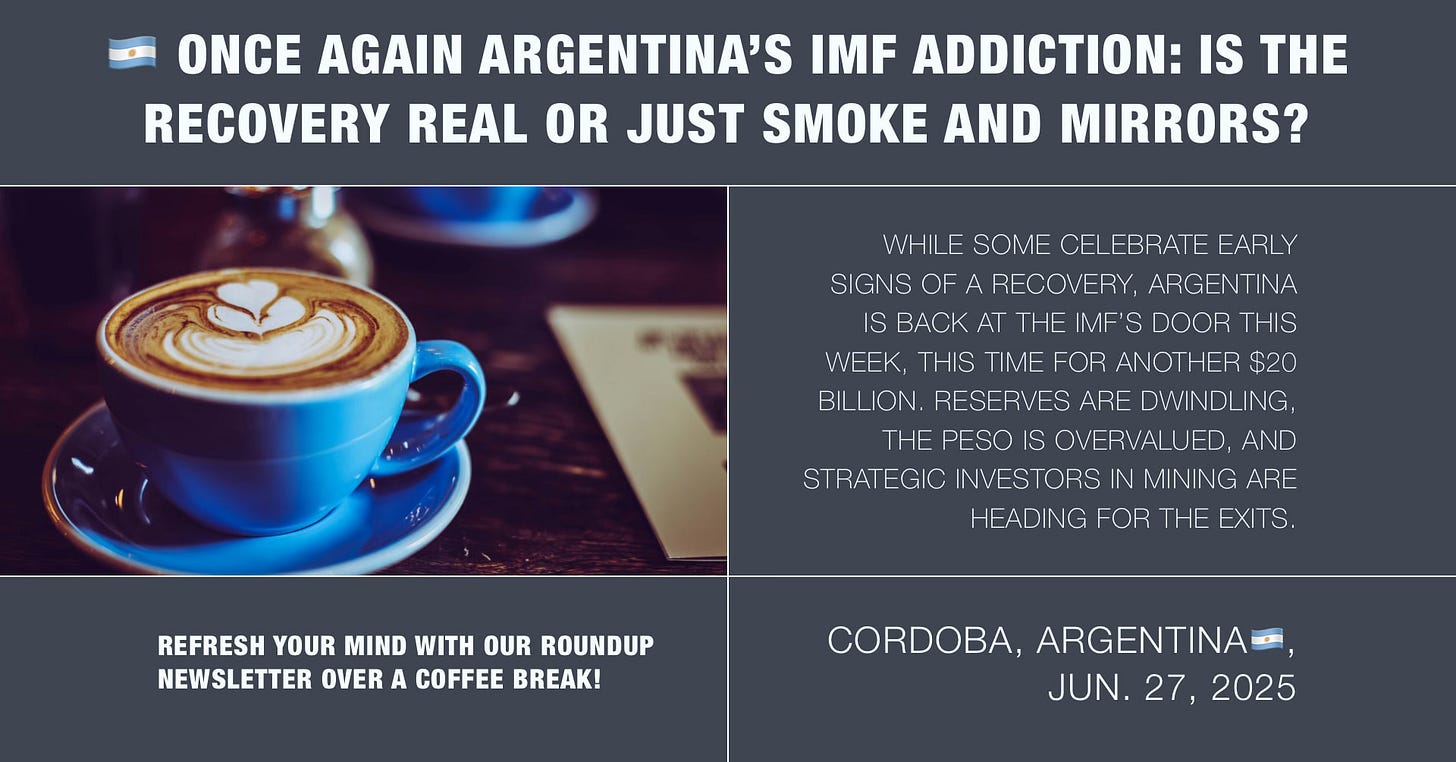🇦🇷 Argentina’s Uneven Recovery: Once Again IMF Talks and the Challenge of Sustained Growth
Explore Argentina's latest $20B IMF deal and the structural risks undermining its 2025 economic recovery. Learn why an overvalued peso, investor flight, and export imbalances threaten stability.
Cordoba, Argentina🇦🇷, Jun. 27, 2025
While the digital skies light up daily with a fireworks display of social media optimism—Argentina, we're told, is now a “paradise for investors”—reality continues to throw cold water on the hype. This week, once again, the Argentine government knocked on the doors of the International Monetary Fund. The ask: another $20 billion loan. Just months ago, the figure was $42 billion.
The reason?
Persistent economic fragility and a dangerously low level of foreign currency reserves.
Let’s be blunt. A country defaulting ten times in a century, and reaching out to the IMF every three years on average since its founding, is not your textbook case of an “investment paradise.” Especially when the nation in question boasts world-class natural resources, a strong agricultural base, highly educated citizens, and a thriving creative economy. Something doesn't add up.
So where did all the IMF money go? Is it being poured into a libertarian experiment at the Casa Rosada—or merely vanishing into the same institutional black holes that have plagued Argentina for decades?
It may be recalled that a few weeks ago, the president of the nation, Javier Milei, proclaimed tax and financial fraudsters to be the heroes of our time. A social media battle cry in the libertarian bubble, or the blueprint of Argentine reality for decades—completely independent of who is currently responding?
The IMF Deal - A Familiar Tango
In March 2025, Economy Minister Luis Caputo confirmed a new $20 billion agreement with the IMF—the 23rd such arrangement in Argentina’s financial history. This latest deal seeks to stabilize the peso, rebuild central bank reserves, and reassure global markets jittery about the country’s long-term solvency.
To be fair, there has been progress:
Inflation has fallen sharply from a shocking 211% in 2023 to a projected 40% by the end of 2025
The government posted its first budget surplus in years
Key reforms are being pushed forward, albeit slowly
But the elephant in the room remains: reserves are still vanishing, and the peso is being artificially propped up using IMF funds.
Recovery? Yes. But Not Enough.
After two tough years of contraction, Argentina’s economy is technically growing again. GDP rose 6.1% year-on-year in Q1 2025. A promising headline—but look closer:
Quarter-on-quarter growth slowed to 0.8%, down from 2.0% in Q4 2024
Exports fell 1.5%, hit by an overvalued peso
Imports surged 17.7%, as restrictions were lifted and domestic demand rebounded
Government spending contracted, due to aggressive austerity, squeezing public wages and consumption
The result? An economy trying to sprint with weights tied to its ankles.
Sectors in Motion: Who’s Gaining, Who’s Sinking
There’s momentum in:
Financial services,
Agriculture and
Trade.
But...
Utilities and hospitality remain underwater
Construction, while recovering, is still reeling from deep cuts to public works projects
Private consumption and investment are rising, thanks to easing inflation and improving credit access. But the 25.4% year-on-year surge in imports (January 2025) suggests a mismatch: domestic demand is returning faster than export capacity can catch up. Not a recipe for sustainable recovery.
The Peso Problem: A Risky Bet
The government is using IMF funds to artificially support the peso—a short-term strategy to curb inflation and calm markets. But it comes at a cost:
Exports become less competitive
Imports become cheaper, worsening the trade balance
Speculation grows around a looming devaluation
Economists have warned for years: this kind of “dirty float”—spending reserves to anchor the currency—is a dangerous game. It may buy time politically, but it deepens structural vulnerabilities.
Strategic Investors Are Eyeing the Exit
Argentina’s mining and commodities sector—particularly in lithium, copper, and rare minerals—has long been a magnet for foreign capital. Optimism peaked in 2024, with projections of $13 billion in mineral exports annually by 2025.
But that narrative is now unraveling.
Several major strategic investors are signaling plans to pull out—citing concerns over currency manipulation, inconsistent regulations, and unpredictable macroeconomic signals. This isn't just capital flight; it's a confidence crisis.
Without that hard currency from exports and investment, Argentina’s reserve accumulation goals—and its ability to pay back the IMF—start looking dangerously unrealistic. Any surprise?
At a Crossroads: Crisis or Correction?
The OECD still forecasts 5.2% GDP growth for 2025, and 4.3% for 2026. On paper, the numbers suggest a country on the rebound.
But the path forward is narrow and full of risk:
Trade imbalance due to rising imports and weak exports
Pressure on reserves if capital flight accelerates
Investor skepticism as strategic players pull out
IMF fatigue, if reforms don’t deliver more than temporary stabilization
The real danger? Argentina may once again win short-term battles—like curbing inflation and securing IMF deals—while losing the long-term war for credibility and structural resilience.
The Mirage of Stability
Argentina’s recent performance shows flickers of hope. But behind the celebratory headlines, deep vulnerabilities remain. President Javier Milei’s administration is playing a high-stakes game: using IMF funds to support an overvalued peso while betting that fiscal reforms will attract enough confidence to sustain growth.
So far, the bet looks fragile.
Until Argentina addresses its overvalued currency, its dependency on IMF bailouts, and the erosion of investor confidence, the “paradise” narrative will remain just that—a narrative.
A more sustainable path forward would mean:
Allowing the peso to float more freely
Using IMF funds for productive investment, not currency props
Rebuilding institutional trust with both domestic and foreign investors
If it fails to do so, Argentina risks repeating its long history of boom, bust, and bailout. And this time, the world may not be as patient—or as generous.—”TangoTech”, iMB ARG🇦🇷Team for iMB.Solutions
Meet “TangoTech”, team member of the dynamic duo behind the innovative crypto currency project for Argentina: CryptoARGVault.
"TangoTech" is a visionary young entrepreneur from Cordoba, Argentina. Her career in finance and economics laid the foundation for her deep understanding of the unique challenges faced by the Argentine economy. TangoTech believes in the potential of blockchain to reshape financial landscapes and empower individuals. Her interest in crypto stems from a desire to create inclusive financial solutions that can transcend geographical boundaries and traditional financial barriers. TangoTech is passionate about community engagement and user experience design. She thrives on building bridges between technology and real-world applications. In her free time, TangoTech is an enthusiastic sustainable whine growing professional and loves exploring Argentina's rich cultural heritage.









